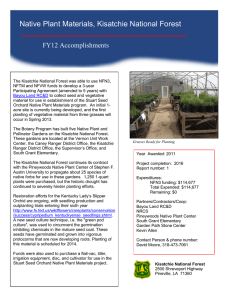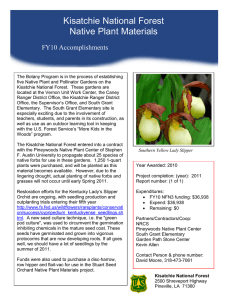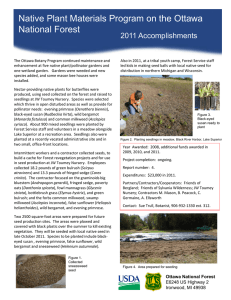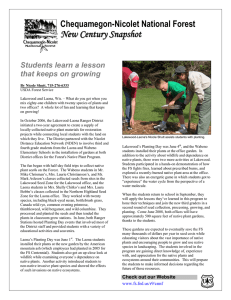Document 11872743
advertisement
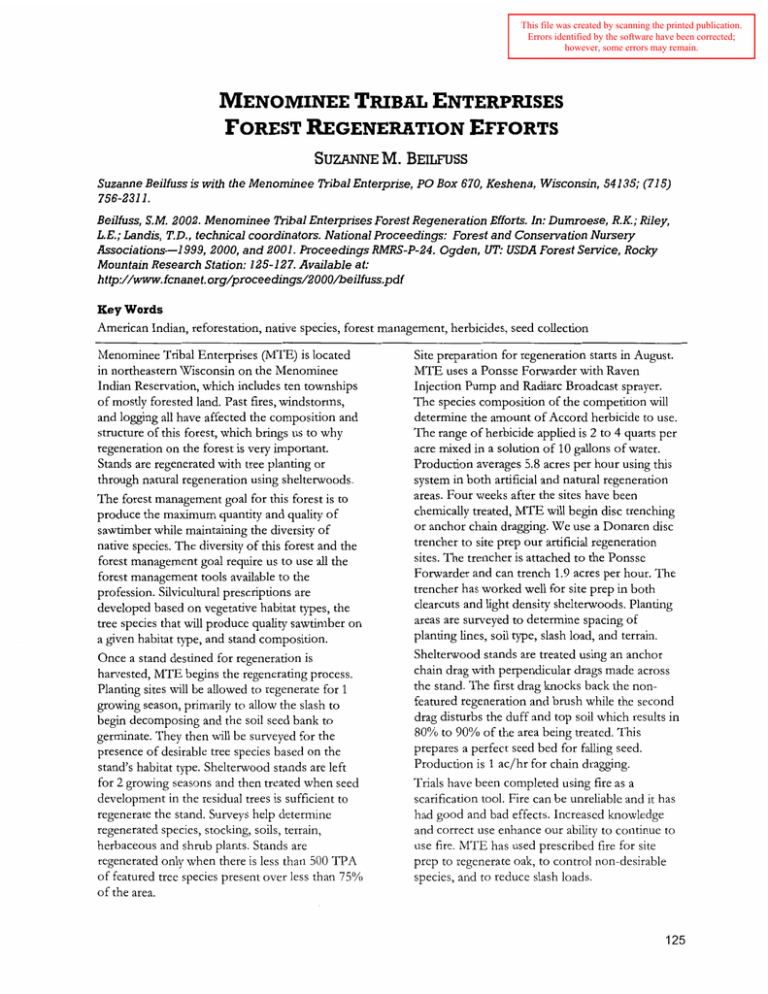
This file was created by scanning the printed publication. Errors identified by the software have been corrected; however, some errors may remain. Suzanne Beilfuss is with the Menominee Tribal Enterprise, PO Box 670, Keshena, Wisconsin, 54135; (715) 756-2311. Beilfuss, S.M. 2002. Menominee Tribal Enterprises Forest Regenera tion Efforts.In: Dumroese, R. K.; Riley, L.E.; Landis, T.D., technical coordinators. National Proceedings: Forest and ConservationNursery Associations-1 999,2000, and 2001. Proceedings RMRS-P-24. Ogden, UT: USDA Forest Service, Rocky Mountain Research Station: 125-127. Available at: h ttp://www.fcnanet.org/proceedings/2000/beilfuss.pdf Key Words American Indian, reforestation, native species, forest management, herbicides, seed collection Menominee Tribal Enterprises (MTE) is located in northeastern Wisconsin on the Menominee Indian Reservation, which includes ten townships of mostly forested land. Past fires, windstorms, and loggmg all have affected the composition and structure of this forest, which brings us to why regeneration on the forest is very important. Stands are regenerated with tree planting or through natural regeneration using shelterwoods. The forest management goal for this forest is to produce the maximum quantity and quality of sawtimber while maintaining the diversity of native species. The diversity of this forest and the forest management goal require us to use all the forest management tools available to the profession. Silvicultural prescriptions are developed based on vegetative habitat types, the tree species that will produce quality sawtimber on a given habitat type, and stand composition. Once a stand destined for regeneration is harvested, MTE begins the regenerating process. Planting sites will be allowed to regenerate for 1 growing season, primarily to allow the slash to begin decomposing and the soil seed bank to germinate. They then will be surveyed for the presence of desirable tree species based on the stand's habitat type. Sheltenvood stands are left for 2 growing seasons and then treated when seed development in the residual trees is sufficient to regenerate the stand. Surveys help determine regenerated species, stocking, soils, terrain, herbaceous and shrub plants. Stands are regenerated only when there is less than 500 TPA of featured tree species present over less than 75%~ of the area. Site preparation for regeneration starts in August. MTE uses a Ponsse Forwarder with Raven Injection Pump and Radiarc Broadcast sprayer. The species composition of the competition wdl determine the amount of Accord herbicide to use. The range of herbicide applied is 2 to 4 quarts per acre mixed in a solution of 10 gallons of water. Production averages 5.8 acres per hour using this system in both artificial and natural regeneration areas. Four weeks after the sites have been chemically treated, MTE will begin disc trenching or anchor chain draggmg. We use a Donaren disc trencher to site prep our artificial regeneration sites. The trencher is attached to the Ponsse Forwarder and can trench 1.9 acres per hour. The trencher has worked well for site prep in both clearcuts and light density shelterwoods. Planting areas are surveyed to determine spacing of planting lines, soil type, slash load, and terrain. Shelterwood stands are treated using an anchor chain drag with perpendicular drags made across the stand. The first drag knocks back the nonfeatured regeneration and brush while the second drag disturbs the duff and top soil which results in 80% to 90% of the area being treated. Thls prepares a perfect seed bed for falling seed. Production is 1 ac/hr for chain draggng. Trials have been completed using fire as a scarification tool. Fire can be unreliable and it has had good and bad effects. Increased knowledge and correct use enhance our ability to continue to use fire. MTE has used prescribed fire for site prep to regenerate oak, to control non-desirable species, and to reduce slash loads. In the fall of 1996 we used prescribed fire after herbicide application and the results seem to be excellent. While controlling non-desirable stems, the nutrients released from the ash layer gave the spring-planted seedlings a boost. Two years after the burn, herbaceous plants (bracken fern and perennials) are the only competitors. Because of site prep, primarily herbicide, competition in regenerated stands the following year is minimal when compared to areas where no site prep has been done. In order to obtain seed for nursery stock, MTE observes seed development in 3 species: white pine, red oak, and eastern hemlock. This begins in spring using a spotting scope to view the crowns in pre-selected stands looking for immature acorns, cones, and flowers. Once seed development in the stands is confirmed, the stands are monitored throughout the summer. When the seed is nearing maturity, it is checked to determine cotyledon development, the number of viable seeds, and to determine if insects have destroyed the seed crops. Seeds are sliced in half and magnified through a hand lens or a scope. Trees are then graded within each stand based on the quantity and quality of developing seeds. Each species' seed develops at different rates and needs to be picked before full development, but not until the cotyledons have reached 75% development. The trees are selected and then felled so the fruit can be stripped from their branches, bagged in feed bags, stored in refrigeration between 32 OF and 38 OF, and delivered to the nursery. Red oak seeds are monitored in the same respects as the conifer, but the acorns are collected from superior trees in red oak timber stands after the acorns fall to the ground. Again the seeds are gathered, bagged, refrigerated, and delivered to the nursery. Production and development of each year's crop determine the amount of seed collected. Some of the oak seeds are kept by MTE and direct seeded at 1,000 to 3,000 nuts per acre the following spring after being stratified in seedbed trays. Trays should not be packed tightly with acorns in order to ensure survival and germination. A fungicide is sprayed over the seed before they are buried 6 to12 inches below the soil surface. Sandy sites are selected for good water drainage. Seeds destined for planting stock are sent to the nursery. They extract the seeds from the cones and plant them for us. Red oak acorns are directly planted. In 1 to 3 years, depending on the growth schedule for each species, the seedlings are purchased back from the nursery. Seedlings are mainly ordered through the state nursery, although we have expanded by ordering from private nurseries when the state nursery could not provide seedlings or species. All state orders are bulk orders, which are not graded. Boxed and bagged seedlings are shipped and stored in refrigerated vans. They are graded and prepped based on MTE's culling guidelines. Graded seedlings are dipped in Liquid-gel, reboxed, and checked for accuracy. Each box is labeled with species, size, date arrived, prepped amount, date, and crew personnel's name and unit number. Plant moisture stress tests are performed randomly on graded and non-graded seedlings. Seedlmgs that are being planted have to be kept cool on the planting site. Crews use insulated trailers and/or reflector tarps to cover boxed seedlings. Most crews are able to plant 1 to 1.5 acres per person per day. Menominee Tribal Enterprises plants, on average, 350 acres each year at densities of 900 TPA for conifers and 750 TPA for hardwoods. Interplanting (fill-in planting) is determined by survival reports. MTE inter-plants when stocking is less than 750 TPA for conifers and 500 TPA for hardwoods. Survival averages around 95%, which is a direct result of chemical and scarification site prep, excellent planting standards, and quality seedlings selected for planting. Direct seeding has not been as successful. We have only direct seeded in the spring with stratified, germinated acorns. By summer time, squirrels or other mammals looking for food consumed 95% of the seeds. T o reduce this, MTE increased the amount of seeds sown per acre, but spring may not be the time to direct seed. Natural regeneration for Menominee Tribal Enterprises has averaged 17,000 TPA 1 year after site prep. Two years after scarification, the average number of stems decrease by 2,000 TPA. Competition may start to become a concern. All stands must meet the criteria that 75% of the area is stocked with desirable tree species at a minimum of 1,000 TPA. Shelterwoods are harvested in the winter months when snow and frozen ground can protect the seedlings. L o g i n g crews must stay on designated s h d trails and directional fell trees to avoid damage to the regeneration. Moderate to high competition levels will require a release treatment. For this, MTE has purchased a Silvana Selective mower head that attaches to the Ponsse Forwarder. Desirable regeneration is released by mowing off the tops of the hardwoods that have overtopped it. REFERENCES Menominee Tribal Enterprises Forest Management Plan 1996-2005, Menominee Tribal Enterprises Silvicultural Handbook, Forest Development, Menominee Tribal Enterprises Young, James A. Seeds of Woody Plants in North America. pp. 248-266.

